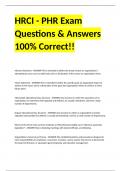HRCI - PHR Exam
Questions & Answers
100% Correct!!
Mission Statement - ANSWER-This is intended to define the broad mission an organization is
attempting to carry out on a daily basis and is a declaration of the reason an organization exists.
Vision Statement - ANSWER-This is intended to define the specific goals an organization hopes to
achieve in the future and is a declaration of the goals the organization wishes to achieve at some
future point.
Mechanistic Operational Org. Structure - ANSWER-Any structure in which the operations of an
organization are extremely well regulated and defined, are usually centralized, and have a large
number of departments.
Organic Operational Org. Structure - ANSWER-Any structure in which an organization is loosely
regulated and possibly less defined, is usually decentralized, and has a small number of departments.
What are the three most common methods an HR professional might use to influence upcoming
legislation? - ANSWER-Mail, scheduling meetings with elected officials, and lobbying.
Organization's Governance Process - ANSWER-The established policies and procedures designed to
meet responsibilities to employees, consumers, investors, and to society; the process is directed by
the board of directors, or equivalent governing body, and executive management.
,Corporate Governance - ANSWER-The interactive and structural configuration, such as hierarchical or
matrix formats, of personnel within an organization that are used my management to influence the
behaviors, culture, and objective outcomes of the organization itself.
Information-rich Communication Channels - ANSWER-e.g. Phone, Videoconferencing, Face-to-Face
Meetings and Presentations
Information-lean Communication Channels - ANSWER-e.g. Email, Fliers, Newsletters, Reports
Involvement Strategies - ANSWER-e.g. Delegating Authority, Employee Survey, Suggestion Program,
Committee, Task Force
Communication Strategies - ANSWER-e.g. Brown-Bag Lunch Program, Department Meeting, Town
Hall Meetings, Open-Door Policy, Management by Walking Around (MBWA)
Conflict of Interest - ANSWER-Occurs when someone with a responsibility to act in the best interest
of the company may also be in the position to derive personal benefit at the expense of the
company.
Human Resources Information Systems (HRIS) - ANSWER-Software systems that contain employee
profiles, workforce features, and reporting tools. Modules of this include applicant tracking, time and
attendance, payroll, benefits administration, and performance management.
Human Capital Management (HCM) Systems - ANSWER-Integrate features that might include
document management, ways to provide policies or benefits summaries access, budgeting and
forecasting, application tracking, succession planning, and engagement and retention tools.
Regression Analysis - ANSWER-Estimates or predicts the unknown values of one variable (dependent
variable, Y) from the known or fixed value of another variable (independent variable, X).
Linear Regression - ANSWER-A type of regression analysis that is used when there is only one
independent variable to consider.
Multiple Regression - ANSWER-A type of regression analysis that is used when there are multiple
independent variables to consider.
, Gene Dalton's Theory of Lasting Change - ANSWER-Change would not occur without a feeling of loss
or pain to motivate it and that people will continue old patterns of behavior unless they feel a need
for change.
Gene Dalton's Change Focus Areas - ANSWER-Gene Dalton developed these four to support change
areas: 1) Generalized goals -> 2) Specific objectives, formal social ties -> 3) New relationships, self-
doubt -> 4) Heightened self-esteem, and external motives for change -> 5) Internal motive for change
Active Listening - ANSWER-An important component of communication that requires paying close
attention to what is being said; it often involves making eye contact and appropriately nodding to
show engagement.
What are the three core elements to a successful staff meeting? - ANSWER-1) Invite all attendees to
share a little. 2) Focus on the group and any outcomes that might need adjustment or improvement.
3) Allow time for feedback in the decision-making process.
Lewin's Change Management Model - ANSWER-1. Unfreezing - Values, attitudes, and behaviors are
challenged, and people understand the need for change.
2. Changing - Occurs during the action phase, whereby the situation is examined, and a new
equilibrium is created.
3. Refreezing - Changes is stabilized and new patterns are solidified.
McKinsey 7-S Model - ANSWER-1) Strategy
2) Structure
3) Systems
4) Shared Values
5) Style
6) Staff
7) Skills
John Kotter's 8-Step Change Model - ANSWER-1) Create a sense of urgency.
2) Build a guiding coalition.
3) Develop a shared vision and strategy.




